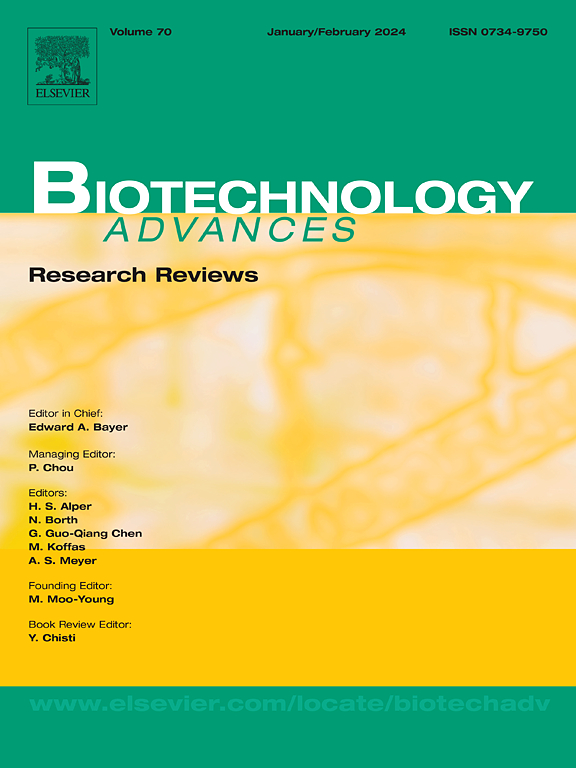Revolutionizing keratinase science: Biocatalytic advances, sustainable innovation, and industrial perspectives
IF 12.5
1区 工程技术
Q1 BIOTECHNOLOGY & APPLIED MICROBIOLOGY
引用次数: 0
Abstract
Keratinases represent a distinct class of proteolytic enzymes capable of depolymerising the highly recalcitrant structure of keratin. In recent years, these enzymes have garnered increasing attention owing to their potential applications in environmental remediation and the circular bioeconomy. This review systematically traces the historical progression of keratinase research, delineates their classification and catalytic mechanisms, and highlights their diverse application spectrum. Keratinases are broadly categorised into serine proteases, metalloproteases, and serine–metallo hybrid proteases, each exhibiting unique structural and mechanistic features. These biocatalysts have demonstrated considerable utility across agriculture, industry, biomedicine, and bioenergy sectors. The advent of protein engineering, artificial intelligence-assisted enzyme design, and synthetic biology has provided powerful tools to enhance keratinase thermostability, catalytic efficiency, and substrate specificity. Nonetheless, their widespread industrial deployment remains constrained by high production costs, suboptimal enzyme stability, and regulatory complexities. Future research should prioritize the development of multifunctional keratinase systems, integrate multi-omics approaches to elucidate keratin degradation pathways at a systems level, and foster interdisciplinary collaborations to address existing technical barriers. Collectively, this review articulates strategic directions for advancing keratinase research and paves the way for their translational applications in sustainable development and resource management.
革命性的角化酶科学:生物催化进步,可持续创新和工业前景。
角蛋白酶是一类独特的蛋白水解酶,能够解聚高度难解的角蛋白结构。近年来,这些酶因其在环境修复和循环生物经济中的潜在应用而受到越来越多的关注。本文系统地回顾了角化酶研究的历史进展,阐述了角化酶的分类和催化机理,并重点介绍了角化酶的多种应用领域。角化酶大致分为丝氨酸蛋白酶、金属蛋白酶和丝氨酸-金属混合蛋白酶,每一种都表现出独特的结构和机制特征。这些生物催化剂已经在农业、工业、生物医药和生物能源领域显示出相当大的效用。蛋白质工程、人工智能辅助酶设计和合成生物学的出现为增强角化酶的热稳定性、催化效率和底物特异性提供了强有力的工具。尽管如此,它们在工业上的广泛应用仍然受到高生产成本、次优酶稳定性和监管复杂性的限制。未来的研究应优先发展多功能角蛋白酶系统,整合多组学方法在系统水平上阐明角蛋白降解途径,并促进跨学科合作以解决现有的技术障碍。总的来说,这篇综述阐明了推进角化酶研究的战略方向,并为其在可持续发展和资源管理中的转化应用铺平了道路。
本文章由计算机程序翻译,如有差异,请以英文原文为准。
求助全文
约1分钟内获得全文
求助全文
来源期刊

Biotechnology advances
工程技术-生物工程与应用微生物
CiteScore
25.50
自引率
2.50%
发文量
167
审稿时长
37 days
期刊介绍:
Biotechnology Advances is a comprehensive review journal that covers all aspects of the multidisciplinary field of biotechnology. The journal focuses on biotechnology principles and their applications in various industries, agriculture, medicine, environmental concerns, and regulatory issues. It publishes authoritative articles that highlight current developments and future trends in the field of biotechnology. The journal invites submissions of manuscripts that are relevant and appropriate. It targets a wide audience, including scientists, engineers, students, instructors, researchers, practitioners, managers, governments, and other stakeholders in the field. Additionally, special issues are published based on selected presentations from recent relevant conferences in collaboration with the organizations hosting those conferences.
 求助内容:
求助内容: 应助结果提醒方式:
应助结果提醒方式:


